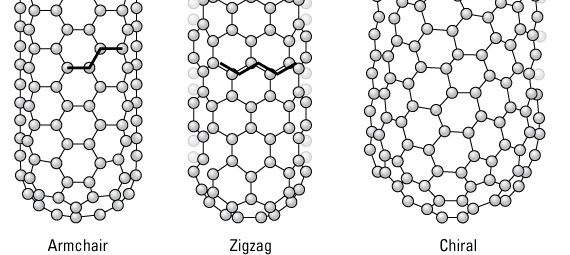Electrical properties of nanotubes
The electrical properties of carbon nanotubes depend on how the hexagons are orientated along the axis of the tube. The following figure shows the three orientations that are possible: armchair, zigzag, and chiral.

Electrical properties depend on the orientation of the hexagons.
Carbon nanotubes with the hexagons orientated in the configuration labeled armchair (hexagons are lined up parallel to the axis of the nanotube) have electrical properties similar to metals. When you apply a voltage between two ends of an armchair nanotube, a current will flow. An armchair carbon nanotube is, in fact, a better conductor than the copper normally used in electrical wire, or any other metal.
Researchers are developing methods to spin carbon nanotubes together to make low-resistance electrical wires that could transform the electrical power grid, as we discuss in Chapter 5, as well as reduce the power consumed and weight of wiring in such power- and weight-sensitive uses as spacecraft and airplanes. Another use that these armchair carbon nanotubes are being considered for is to connect devices in integrated circuits. As devices in integrated circuits become smaller, it may not be possible to pattern narrow enough metal lines, so researchers are considering using armchair carbon nanotubes to replace the metal lines.
The next two possible orientations of hexagons in carbon nanotubes share electrical properties similar to semiconductors. Those with the hexagons oriented in a circle around the nanotube have a configurations labeled zigzag. Those with a twist to the nanotube so the hexagons do not form any line are called chiral. These two configurations of nanotubes will only conduct an electric current when extra energy in the form of light or an electric field is applied to free electrons from the carbon atoms. Semiconducting nanotubes could be useful in building the ever smaller transistors used by the hundreds of millions in integrated circuits for all kinds of electronic devices.
TechnicalStuff
Another interesting property of carbon nanotubes is that their electrical resistance changes significantly when other molecules attach themselves to their carbon atoms. Companies are using this property to develop sensors that can detect chemical vapors such as carbon monoxide or biological molecules.
Excerpted from Nanotechnology For Dummies (2nd edition), from Wiley Publishing